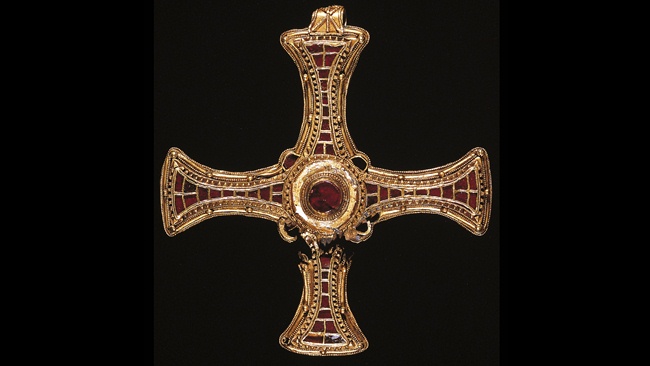
Newsletter
Yes! Send me my FREE short story collection and sign me up for those exclusive subscriber goodies!
We value your privacy, and will never spam you! View our privacy policy at lasmithwriter.com/privacy

Yes! Send me my FREE short story collection and sign me up for those exclusive subscriber goodies!
We value your privacy, and will never spam you! View our privacy policy at lasmithwriter.com/privacy
In this series about St. Cuthbert’s grave, I have looked at two treasures so far: the Gospel Book and the coffin. Today I am going to examine a third: the cross.
I’ve detailed before the long and arduous tale of St. Cuthbert’s remains, so I won’t go into it here. Look up my previous posts if you are new to this series! Suffice it to say, poor St. Cuthbert didn’t exactly enjoy a peaceful rest. His coffin was opened numerous times and carried all over northern England before finally being interred in Durham Cathedral, where it resides today.
With all the opening and closing of the coffin, and especially with the less-than-reverent looting of King Henry’s soldiers during the Dissolution of the Monasteries, it’s actually amazing anything survived at all.
But it’s particularly amazing that Cuthbert’s beautiful little cross is still with us today.
In 1827, the coffin was opened for the final time (one hopes!). Underneath his robes, lying next to his (now decomposed) body, the little cross was found. It was broken in a couple of places. One, near the top, where it looked like it had been yanked off the cord somehow and then repaired in Cuthbert’s lifetime. The second break was due to the cross being in contact with the decomposing body and the internal frame of the cross had eroded. It was found broken in the tomb.
There are some scholars who postulate that this cross was added to the tomb sometime after Cuthbert’s death, but in general, most agree that this was Cuthbert’s personal cross, worn by him during his lifetime and buried with him when he died.
The design elements of the cross and its similarity to the only four other examples from this time period show that it was certainly created in Cuthbert’s lifetime, whether or not it was placed with him when he died or sometime after. One of the interesting things about it is that the other crosses like this have only been found buried with females.

The central garnet (the hinged section) is bordered by a shell, which came either from the Meditteranean or perhaps the Indian Ocean. The remains of a gold chain were also found with the cross. Image from patricialovett.com
The cross was created in the typical Anglo-Saxon style of the time, crafted in gold with garnet inserts. The garnets are shaved into thin slices, and placed on top of gold, making them glow in the light. It displays exquisite craftsmanship, both in the design and in the object itself. Keep in mind the small size of the cross and think about how difficult it would be to make this. I am constantly in awe of the Anglo-Saxon goldsmiths and jewelers who made these beautiful pieces!
There is a great deal of religious symbolism in this cross, as well. Starting with the shape, of course! But aside from that, you will notice that each arm of the cross contains twelve garnet sections. This was likely deliberate, to symbolize the twelve disciples of Jesus. The garnets themselves symbolize the red blood of Jesus’ sacrifice. The center section is actually hinged, to allow for the placement of a very small relic inside, such as the fingernail or piece of hair of a saint.
This little cross was likely worn often by Cuthbert. Perhaps at the important feast days of the Church, or perhaps every day, nestled close to his heart under his robes, as it was found at his death.
I’m so very glad Henry’s soldiers missed this lovely cross in their looting of Cuthbert’s shrine. It is such a personal and tangible link to this remarkable man who lived so very long ago.
Want more on the cross? Here’s an interesting ten-minute talk from Durham Cathedral on thier most treasured object.
Love Anglo-Saxon history? Enjoy fantasy? Why not read my historical fantasy books, set in 7th-century England? Wilding and Bound are available NOW. Book Three is coming SOON!